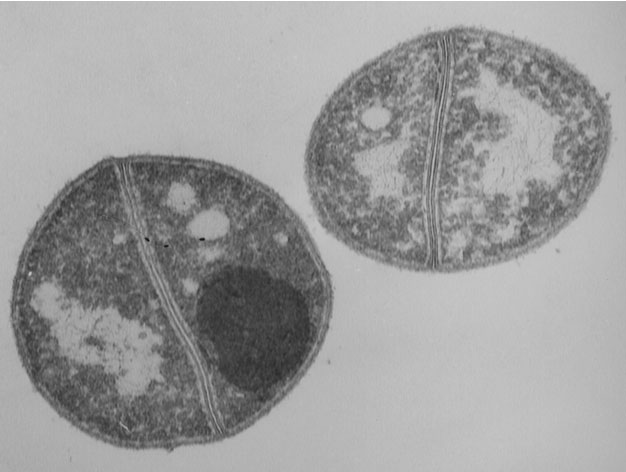Microlunatus phosphovorus NM-1T(= NBRC 101784T)
Aquatic eutrophication and bloom of toxic algae triggered by release of phosphorus in wastewater have been recognized as environmental problems. The enhanced biological phosphate removal (EBPR) has widely utilized for removing phosphorus from wastewater and preventing phosphorus from diffusing into environment. Polyphosphate accumulating organisms (PAOs) are frequently found in activated sludge in the EBPR process, and believed to play a pivotal role in phosphorus removal. PAOs are microorganisms which take up phosphate into the cells and accumulate it as the form of polyphosphate (polyP) under aerobic conditions. In additions to polyP accumulation, PAOs are supposed to synthesize polyhydroxyalkanoates (PHAs), known as a source of bioplastics. Therefore, PAOs have received industrial attention for their possible use in phosphorus recycling and supply of biodegrative plastics.
Microlunatus phosphovorus NM-1T is an actinobacterium isolated from EBPR activated sludge, as one of rare examples isolated successfully from such an environment. M. phosphovorus NM-1T represents competent features as PAOs; it can accumulate polyP more than 10% of cell mass as phosphorus on a dry weight basis. In addition, a recent study using PHA staining and gas chromatography suggested the presence of PHAs in cells of M. phosphovorus.
The genome of M. phosphovorus NM-1T consisted of a single circular chromosome (5,683,123 bp; G+C content of 67.3%) containing 5,359 predicted protein-coding genes. The M. phosphovorus genome possessed a larger number of genes related to polyP accumulation than other related microorganisms. On the other hand, the homologous genes which are involved in PHA synthesis in proteobacterial PAOs were not observed in M. phosphovorus, suggesting that the organism possibly contains an unknown PHA biosynthetic pathway. Minute analysis of this genome will give useful information and a new insight to investigation about biological mechanisms of polyP accumulation and production of bioplastics.

Photo by Advanced Industrial Science and Technology (AIST)
References:
- [1] Accumulation of polyhydroxyalkanoates by Microlunatus phosphovorus under various growth conditions.
- Akar A., Akkaya EU., Yesiladali SK., Celikyilmaz G., Cokgor EU., Tamerler C., Orhon D., Cakar ZP. (2006)
J Ind Microbiol Biotechnol. 33:215-20. [PMID:15660231] - [2] Microlunatus phosphovorus gen. nov., sp. nov., a new gram-positive polyphosphate-accumulating bacterium isolated from activated sludge.
- Nakamura K., Hiraishi A., Yoshimi Y., Kawaharasaki M., Masuda K., Kamagata Y.(1995)
Int J Syst Bacteriol. 45:17-22 [PMID:7857797]
| Genomic size | 5,683,123 bp |
|---|---|
| The number of ORFs | 5,359 |
| GC content | 67.27% |
| Genome Database | DOGAN |
| NBRC* No. | 101784 |
- * The URL of NBRC:
- http://www.nbrc.nite.go.jp/e/index.html.
- Distribution of Our Microbial Genomic DNAs
- At the Biological Resource Center of the National Institute of Technology and Evaluation (NITE Biological Resource Center, an Incorporated Administrative Agency), we have been distributing the microbial genomic DNA.
Contact us
- Biotechnology Evaluation and Development Division, Biological Resource Center, National Institute of Technology and Evaluation
-
Address:2-49-10 Nishihara, Shibuya-ku, Tokyo 1510066, Japan MAP
Contact Form


